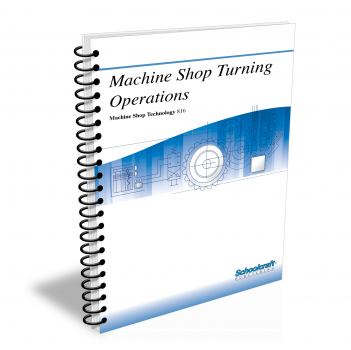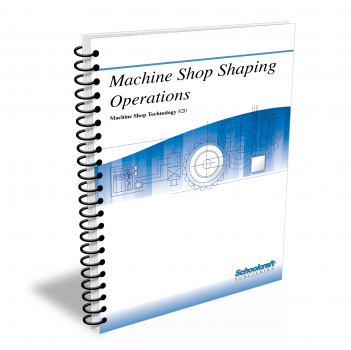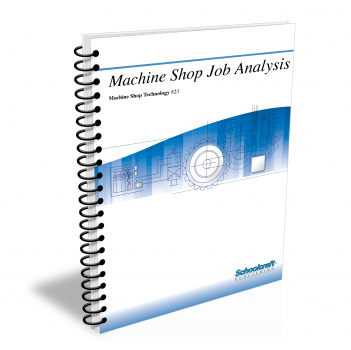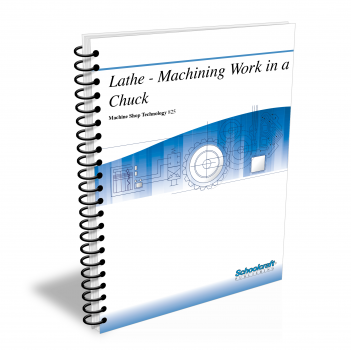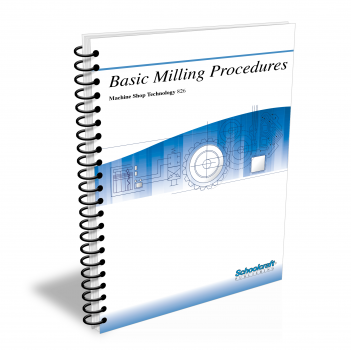Machine Shop Practice
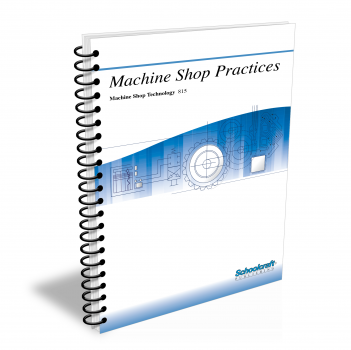
Course Number: 815
The Machine Shop Practice textbook covers the principles of machining, measurement, tool grinding, and machine shop safety. It discusses the properties of metals, how to lay out and set up a job, how to use measuring devices such as the micrometer and vernier caliper, and how to read working drawings. It concludes by explaining how to grind single-and multi-point tools.
Does your curriculum require additional topics not included in this textbook? Build a customized version of the Machine Shop Practice textbook below.
Recommended Contact Hours – 9
Preview a Chapter
Available Supporting Material
- Table of Contents
- Exam Copies
- Suggested Titles
Table of Contents
Chapter 1: Principles of Machining
Topics: Machine tools; Metal cutting tools; Properties of metals; Case hardening; Cutting metals; Cutting fluids; Speeds and feeds; Chip shape and disposal
Learning Objectives:
- Name the two main classes of machine tools.
- Tell how to identify ferrous and nonferrous metals.
- Explain methods of identifying steels.
- Define the following terms: tensile strength, compressive strength, ductility; and malleability.
- Explain various heat treating processes used with metals.
- List the functions of a cutting fluid.
- Explain how to change sfpm to rpm.
- Describe the information you can gather from chip color and shape.
Chapter 2: Layout Work and Shop Safety
Topics: Shop drawings; Scribing lines; Calipers; Measuring angles; Surface plates, gauge; Making a layout; Shop safety
Learning Objectives:
- Describe the tools commonly used for layout work in the machine shop.
- Explain the function of a surface plate.
- Define the terms bolt circle, pitch chord, and centerline.
- List the steps involved in laying out flange holes.
- Explain shop safety practices relating to eye protection, chip removal, and tool handling.
Chapter 3: Setup Tools
Topics: Holding devices; Supporting the workpiece; Rests; Step blocks; V-blocks; C-clamps; Angle plates; Hold-downs; Magnetic chucks; Safety
Learning Objectives:
- Explain how to hold and drive work held between centers on a lathe.
- Explain how to hold lathe work in a chuck, and how to mount and remove a chuck from a lathe.
- Define the term swing as it relates to a lathe.
- Tell how to hold oddly shaped workpieces on a lathe
- Explain when each of the following is used: collet chuck, steady rest, and follower rest.
- Explain how each of the following is used to hold work on a machine table: T-slot bolts and clamps, step blocks, V-blocks, C-clamps, angle plates, and planer jacks.
- Tell when and how to use a vise to hold a workpiece.
- List safety precautions for setup tools.
Chapter 4: Setup Measurement
Topics: Working drawings; Dimensions; Precision; Tolerance; Using a steel rule, micrometer, vernier caliper, sine-bar, and gauge blocks
Learning Objectives:
- Explain the importance of having a working drawing when machining a part.
- Define the terms section and sectional view.
- Name the three systems of dimensioning.
- Define the terms precision and tolerance.
- Define the term fit, and compare actual fit, clearance fit, interference fit, and transition fit.
- Name the simplest measuring tool in the shop.
- Explain how to hold and read a micrometer.
- Tell how to use a vernier caliper, sine-bar, and gauge blocks.
Chapter 5: How to Grind Single-Point Tools
Topics: Tool materials; Relief angles; Grinders and grinding wheels; Finishing, grooving, and threading tools; Carbide-tipped tools
Learning Objectives:
- Describe the various materials used for tools.
- Identify the parts of a single--point tool.
- List important specifications for single-point cutting tools.
- Name the two basic types of grinders and explain how they are used to sharpen single-point tools.
- Explain the standard marking system for grinding wheels.
- Describe the best way to grind carbide-tipped tools.
Chapter 6: How to Grind Multi-Point Tools
Topics: Grinding a drill; Checking lips and relief angles; Thinning the drill web; Milling cutters; Cutter relief, clearance, end mills, and counterbores
Learning Objectives:
- Describe the construction of a twist drill, including identification of its parts.
- Explain how to perform the following operations when grinding: check the drill lips, check the relief angles, and thin the drill web.
- List the three categories of milling cutters based on the way they are mounted on a milling machine.
- Name the most common type of milling cutter for maintenance work.
- Explain how to grind end mills, counterbores, and reamers.
Request Exam Copies
Exam Copies
Ready to see a copy of our textbooks? After selecting which textbooks you’d like to review for your course, you can submit your request by either logging in or creating an account so we know where to ship your exam copies. A representative from Schoolcraft will contact you to confirm and finish processing your request.
Exam copies are always free and yours to keep.
Selected Exam Copies
none selected
* Maximum of five copies can be ordered
